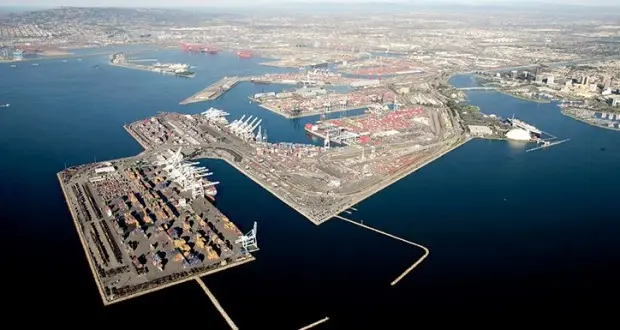Port of Long Beach reports air quality improvements

In its latest study of air pollution emissions, the Port of Long Beach noted clean air records, including an 88 percent reduction in diesel particulate matter, continuing more than a decade of air quality improvements.
The first phase of the zero-emissions Long Beach Container Terminal opened on Pier E in 2016, helping to drive down the air pollution tallied in the Port’s annual Emissions Inventory, which was completed this week. The Port has been monitoring its progress in air quality improvements since 2005.
“The Port of Long Beach, in partnership with the Port of Los Angeles, has been a global leader in reducing pollution associated with goods movement,” said Long Beach Mayor Robert Garcia. “We’re committed to a zero-emissions future and our Port continues to prove that you don’t have to sacrifice the environment for a strong economy.”
The inventory, conducted by an independent consultant, found the Port’s aggressive actions to cut pollution have decreased diesel particulate matter a record 88 percent since 2005. Smog-forming nitrogen oxides were down 56 percent, also a record. Sulfur oxides held steady at 97 percent lower and greenhouse gases are down 22 percent, another record.
As part of the first Clean Air Action Plan adopted in 2006, the Port’s efforts to improve air quality have included the Clean Trucks Program, low-sulfur fuel regulations for ships, increased use of shore power for container ships and the Port’s Green Flag Vessel Speed Reduction Program.
With the opening of Long Beach Container Terminal, 11 percent of the Port’s fleet of cargo-handling equipment is zero-emissions.
“We have a greater percentage of our cargo-handling equipment operating at zero emissions than any other seaport in the country,” said Port of Long Beach Executive Director Mario Cordero. “As we chase our goal of becoming a zero-emissions port, it’s important for us to increase that number to help make the technology more commercially viable.”















![AIRBUS A380 [MORE THAN 600 PASSENGER’S CAPACITY PLANE]](https://cdn.tinn.ir/thumbnail/4jCp4EQvCU0b/IjHVrSYQrIAqIzXuTzADR7qLYX4idQT4nfq__26E5SCUPLMqfhWkWajvuO9Wfq1ql1TjV4dhkrHliNQU82kMpo2NNftT_NGEwHc9KXtN_rk731bmifa2IQ,,/airbus-a380-structure1.jpg)

Send Comment